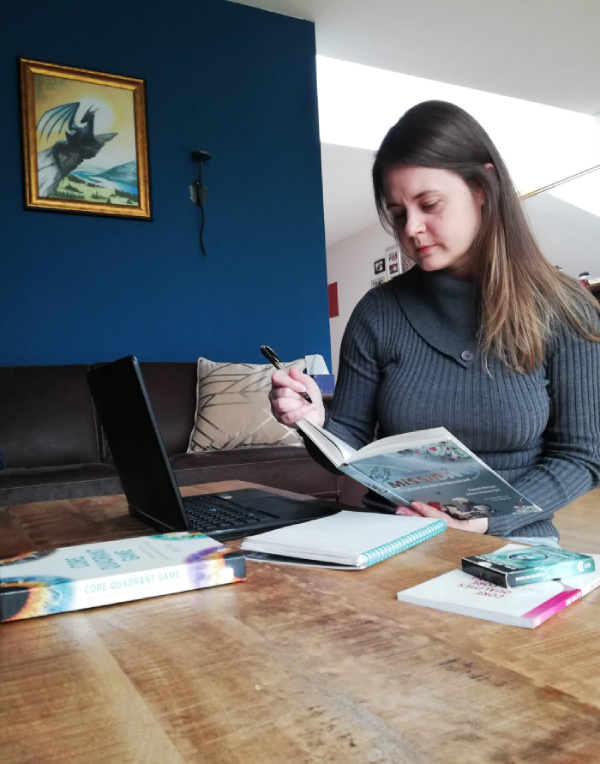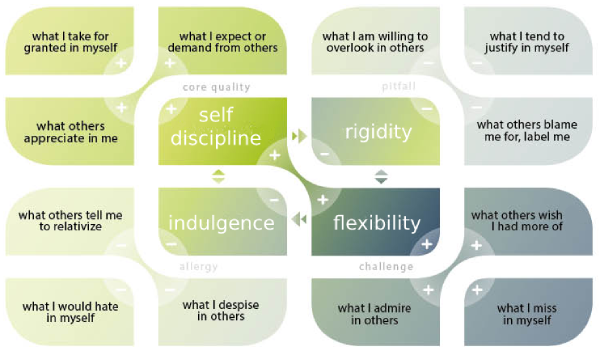
“The Core Quadrant model is well known throughout Europe as a technique taught in both the education systems as well as to professionals such as managers, coaches and councelors. However, it is still relatively unknown in North America.”
Mission 9: The Secret of the Core Quadrants is about children who discover a way for all different types of people to understand and get along with each other (see a full description below). The story teaches the principles of the Core Quadrant model, founded by Daniel Ofman, in a fun and easy-to-understand way.
I was approached by Albert, one of the authors of Mission 9, to do an English translation of his original Dutch novel. He felt that an English version of the book could open doors for the introduction of the Core Quadrant model to North America. He gave me a Dutch copy of the book, as well as introductory material for the model on which the book is based. As I did my first read-through, I was impressed by the accessibility of the concept and the potential benefits of using it in school or work life. I took on the project with pleasure and worked directly with the original authors to bring across their story in the most authentic way possible.
The process was an absolute joy, partly because both Albert and Daniel are such helpful, down-to-earth men with whom I immediately connected. The very first time we all met together we got caught up in a super enjoyable discussion around the model, life and practically everything in between. I came away feeling refreshed, invigorated and ready to see myself and my relations with others in a new light.
I am proud to have my name on the cover of this book, and I can’t wait to see how it inspires a new set of young minds. I hope that, through this translated version, Mission 9 finds a place in the hearts and lives of the English-speaking world as well.

It’s 986 years into the future, and Earth has colonized 8 additional planets. Each planet created a new society based on their most valued qualities – such as on Observia where people place high importance on the presence of logic, structure and science in their everyday lives, or on Authenticum, where people value creativity, originality and beauty over all else. But, the differences in mindset between the planets grew too great, and the inhabited universe is on the verge of all-out war.
Nine children – one from each planet – are sent on a journey in a last-chance effort to discover a way for the planets to find understanding and cooperation before it is too late…
Mission 9 is an engaging and easy way for children and adults alike to get started with the basic principles of understanding core qualities and the benefit of using the Core Quadrant system. It teaches not only that there is strength in the variety found in different types of people, but also the importance of recognizing our difficulties and working through our commonalities to bring balance within ourselves and peace to our lives.
The Core Quadrant model is a way for people to get to know their own strengths and weaknesses. It helps people understand why they relate to others the way they do; like why certain types of people are more difficult for them to get along with than others. This understanding alone can improve our interactions with all different types of people.
We are all born with core qualities, which are abilities or characteristics that come naturally to us, without need for practice or training. Examples include being organized, empathic or self-disciplined. Our strengths lie in recognizing these qualities in ourselves and making use of them in our daily lives.
As is the case with most things in life, however, our good qualities can start to work against us if they are taken too far. The natural strength of having good self-discipline can distort into rigidity or restrictiveness if it is not kept in a healthy balance. When a quality gets out of control in this way, it becomes a pitfall.
What we often need in order to balance us out and reduce the likelihood of allowing our pitfall to take over, is to find our challenge. The challenge is a characteristic which is not naturally part of our set of core qualities, but which we have to learn and work on. Our challenge is always the positive opposite of our pitfall. In the current example, the positive opposite of rigidity is flexibility. Our challenge should come alongside our quality, to support and balance it. If we are naturally good at self-discipline, then learning to be flexibly disciplined allows us to avoid our pitfall.
It is also helpful to understand that it is usually certain triggers which tend to push us overboard into our pitfalls. These triggers occur most often when we encounter people who have pitfalls which are the opposite of one of our qualities. Again using this same example, when the self-disciplined person encounters someone who has slipped into their pitfall of leniency or indulgence, it puts us off. You might say that we have an allergic reaction to such behavior. But, instead of reacting and overcompensating with too much of our own self-discipline, what we can learn to realize, is that the natural quality that the lenient person is taking too far, is in fact flexibility. When we are able to see the qualities in ourselves and each other, we can learn from each other and become more balanced.
Use the example quadrant below and answer the questions to find out what one of your core qualities, pitfalls, challenges and allergies are! Or, download the app for a more guided experience.

Anyone who has ever worked in an office or with many co-workers or clients understands how many different kinds of people, personalities, and work styles there are. Sometimes this causes friction between certain people whose personalities don’t seem to match very well. Why is this? How can it be resolved? Is there a way to prevent these kinds of issues in the first place?
The Core Quadrant model has helped leaders, managers and mentors in professional environments across Europe find the answers to these questions, as well as gives them the tools and training to implement solutions.
Teaching children to see through bias, be tolerant to differences and open to accepting themselves and others is an important part of early education. It is also important for teachers to be aware of the differences in their students and understand that not everyone learns and understands in the same way. By learning and applying the principles of the Core Quadrant model, students and teachers can discover how to connect with each other in more meaningful and helpful ways.
Mission 9 was written as a way to introduce these concepts to elementary and middle school students and can be used as part of a curriculum to work through not only the understanding but also the practice of how it works in real life.